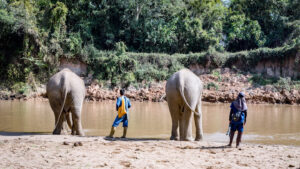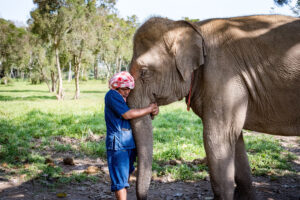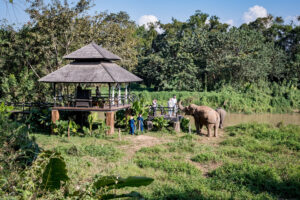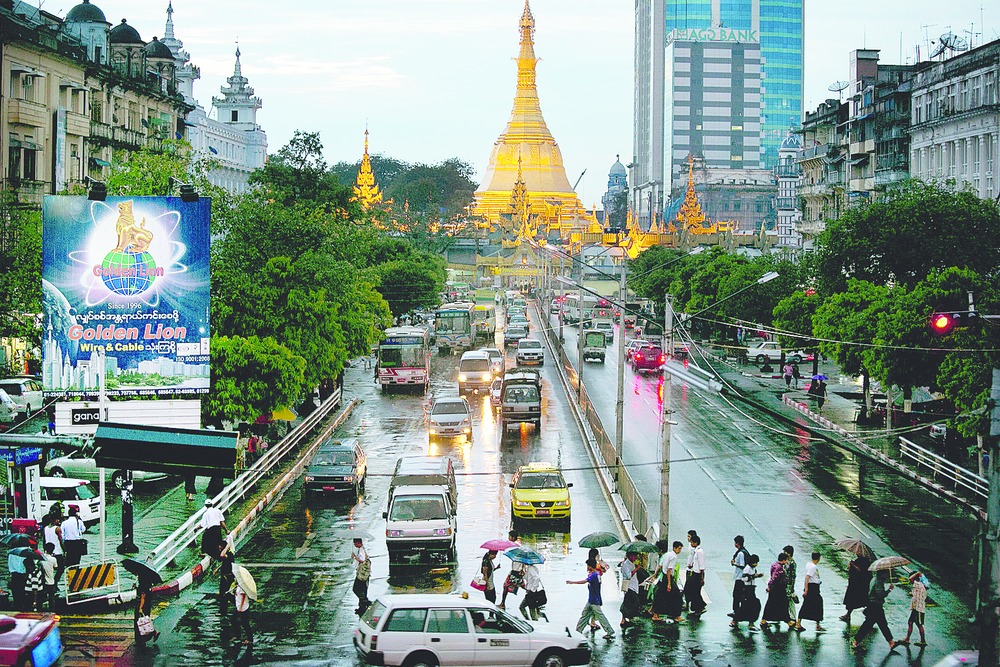 The future of ethical elephant tourism in Thailand
The future of ethical elephant tourism in Thailand
One resort is using this sustainable approach to securing the future of ethical elephant tourism in Thailand
The future of ethical elephant tourism in Thailand
My most shameful moment as a traveler occurred in Thailand.
On my first backpacking trip at the age of 20, I sought out an elephant sanctuary in the Golden Triangle region of Northern Thailand hoping to see an elephant up close. I assumed “sanctuary” meant it was a refuge for elephants but I knew something was off when we were encouraged to climb atop the elephants that were chained to a post.
Ever since, whenever I see the image of an elephant, I see not Thailand’s national emblem, but a symbol of tourism gone wrong. Is it possible to engage in an ethical way with the gentle giant that has been an icon of Thailand for centuries? Determined to find out, I made my first trip back to Thailand.

Finding a reputable elephant sanctuary
I planned to return to the Golden Triangle but this time I did my research. In my search for camps that are engaged in meaningful elephant rehabilitation, Anantara Golden Triangle Elephant Camp & Resort repeatedly came up as a reputable sanctuary. When, within 10 minutes of arriving at the resort, I spotted two elephants freely grazing near the Mekong River, I was eager to find out how the 20 elephants that live there are cared for.
Many of the estimated 3800 captive elephants in Thailand are not treated fairly. Despite being a protected animal under Wild Animal Reservation and Protection Act (WARPA) since 1975, many of the elephants living in tourist facilities are suffering. They often develop nervous habits from anxiety, which was something I witnessed firsthand here. The on-site vet, Dr Nissa Mututanont, explained that the repetitive circle-of-eight figure one elephant was making with their head is a self-soothing technique they continue to exhibit after captivity, even once they’re safe.
This lesson is one of many I learned from Dr Mututanont as she guided us through making elephant energy balls (a giant mound of bananas, tamarind and nutritional pellets we mold with our hands), to walking with the elephants, to showering them under the warm sun. I was relieved to find out there will be no elephant riding — this elephant camp cares more about the rehabilitation of elephants than providing Instagrammable moments to guests. The elephant encounters here are less interactional and more educational, a welcome shift in the nature of elephant tourism that meets the growing pressure from the travel industry and animal welfare groups to protect elephants from the harmful practices — such as caging and beating — traditionally involved in training elephants for tourism. Established in 2003, the Anantara camp works with The Golden Triangle Asian Elephant Foundation (GTAEF) to perform street rescues and provide a comfortable home for elephants, with Dr Mututanont overseeing their nutrition and medical care. To date, the camp has rescued more than 50 elephants, not only providing the gentle giants with a new home, but their mahouts too.

The importance of the elephant–mahout relationship
Despite the 4000-year-old tradition of handling elephants, the mahout is a dying profession. While unethical elephant camps should undoubtedly be closed, there is little consideration for what happens to the elephants and their mahouts afterward. During the pandemic, when travel to Thailand grinded to a halt, the income to take care of elephants dried up too. “Their caretakers need to find an approximate US$20 per day just to feed their elephant, let alone their own family, and meet all their other needs,” says John Roberts, Anantara’s Group Director of Elephants & Conservation. “Elephants consume between six and ten percent of their body weight daily, and it costs approximately US$18,000 a year to look after a single elephant.” Without the support of tourism dollars, mahouts struggle to take adequate care of their elephants.
The mahouts could easily abandon their elephants but they typically don’t, not only because the elephants are their primary source of income, but because they develop a deep bond with the gentle giants too. I sensed this connection when I saw a mahout hugging their elephant’s trunk in a moment of warm embrace. Learning that 70% of the mahouts here came with their elephant, it becomes apparent this is a lifelong relationship, one that plays a large role in determining the elephant’s wellbeing.
The mahout and elephant have their own dialect of commands which, once the elephant is acquainted with their own mahout, they don’t even need to use. The elephants develop such a close relationship with their mahout, they come to treat them like next of kin by, for example, instinctively providing shade over the mahout when they’re sitting in the sun. Rather than a domineering relationship of ownership, the mahout and elephant are more like family — one needs the other to survive.

Supporting former mahouts
It’s why Anantara Golden Triangle Elephant Camp & Resort takes providing for their mahouts as seriously as the rehabilitation of their elephants. The mahouts live on-site and receive three meals a day. The GTAEF supports the mahouts’ families too, providing an education to their children in the nearby villages where they live. As a result of offering English instruction, these local schools have gone from last in the province for average English score to the top one hundred. Given that being a mahout is typically an inherited profession, improving the literacy and education levels of the next generation has the potential to safeguard the future of elephant caretaking too.
But it’s not just the mahouts’ children who receive an education, the mahouts do too, learning ethical elephant training techniques. One of the GTAEF’s most successful free courses has been the “Target Training Positive Reinforcement Workshop,” in which elephants learn how to present parts of their body (for medical inspections like nail trimming and blood tests) by receiving their favorite treat as positive reinforcement. Now in its twelfth year, the training has been so effective the Foundation has expanded to offer it in the neighboring countries of Laos, Myanmar and Cambodia. “To date we have reached over 400 mahouts,” says Dr Mututanont. “The speed at which the new techniques have been adopted by mahouts is so uplifting to see.”
After my unethical elephant experience over a decade ago, I was eager to find an elephant sanctuary that lives up to the meaning of the word — a true place of refuge. I wasn’t surprised to find it exists at Anantara Elephant Camp. I was surprised, however, to discover that ethical elephant tourism in Thailand is as much about supporting the people behind the elephants — the mahouts who look after them — as the elephants themselves.
Source: https://www.lonelyplanet.com/articles/ethical-elephant-sanctuary-thailand



